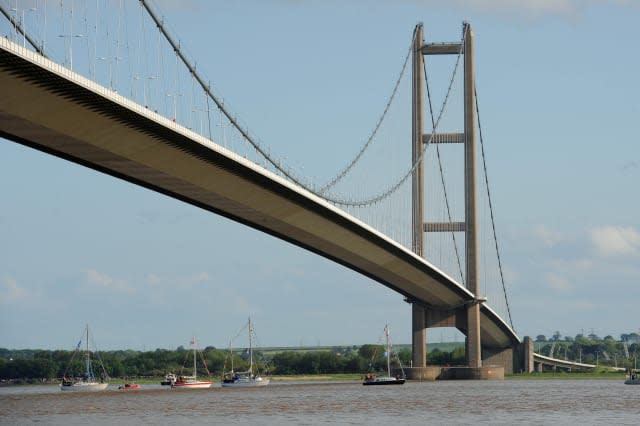Humber Bridge and poet Philip Larkin's home in Hull to receive listed status
The Humber Bridge and the home of poet Philip Larkin are to get listed status as the built heritage of Hull is recognised during its year as UK City of Culture.
Nine places in the city are being listed by the Department for Culture, Media and Sport on the advice of Historic England.
These include the Tidal Surge Barrier, a set of Edwardian-style toilets and the grave of a railway worker whose death inspired new safety measures.

The Humber Bridge gets Grade I listed status on the 36th anniversary of its opening by the Queen on July 17 1981. At 1,410 metres, it was the longest single-span suspension bridge in the world for 17 years and remains in the top 10.
Larkin's flat at 32 Pearson Park has been given Grade II listed status. This is recognised as where he was most creative and where he wrote many of his best-known and most celebrated poems, sitting in the front room overlooking the park.
Some, such as Toads Revisited, specifically reference the park while the title of High Windows, for his final collection, was taken from those of his flat.
Larkin lived in the flat for 18 years when he worked as Hull University librarian and when the property was owned by the university.
The Tidal Surge Barrier, which is also being Grade II listed, is a prominent landmark in the city, where the River Hull meets the Humber. It was built between 1977-1980 to safeguard the low-lying city from flooding from the estuary.
The other six structures being added to the list are:
:: The grave of Edward Booth, who was a 25-year-old railway fireman whose death in the 1906 Ulleskelf station train crash spurred new train safety measures. His grave is in Western Cemetery.
:: The homes of J Arthur Rank and Alfred Gelder at 365-371 Holderness Road. Rank has been called "the saviour of the mid-20th century British film industry" and was born at No 371 Holderness Road shortly after it was built. Alfred Gelder was the only lord mayor of Hull to be elected five times in succession, from 1898.
:: The Nelson Street Edwardian-style public toilets, with art nouveau features, opened in 1926.
:: St Michael and All Angels Church, Orchard Road.
:: The Standidge Buildings, which are late 19th century warehouses, in Chapel Lane.
:: The statue of William de-la-Pole, in Nelson Street.
Hull's Old Town is also being given a boost as it is named as one of Historic England's 10 new Heritage Action Zones - a move that aims to bring it back to life, transforming historic buildings and providing funding to residential developers.
John Glen, minister for arts, heritage and tourism, said: "The great Philip Larkin wrote of the domes, statutes and spires that make Hull unique but it is also architectural triumphs like the Humber Bridge and Tidal Surge Barrier that have helped build the city's reputation.
"What better time than during its year as UK City of Culture to recognise and celebrate the historical and cultural landmarks which tell the story of Hull's illustrious heritage."
Councillor Chris Matthews, chairman of the Humber Bridge Board, said: "The Humber Bridge is an iconic landmark that is loved and appreciated by the people it serves.
"It is a tremendous feat of British engineering that connects Hull and East Yorkshire to North and North East Lincolnshire.
"More than that, however, it connects communities and places, giving people a freedom to live and work on different sides of the estuary which previous generations didn't have.
"Its impressive magnitude and the spectacular views it affords attract thousands of visitors each year.
"To be granted Grade I listed status is a great honour, especially as it is happening in Hull's City of Culture Year."
Hull now has 479 listed buildings - nine at Grade I.


